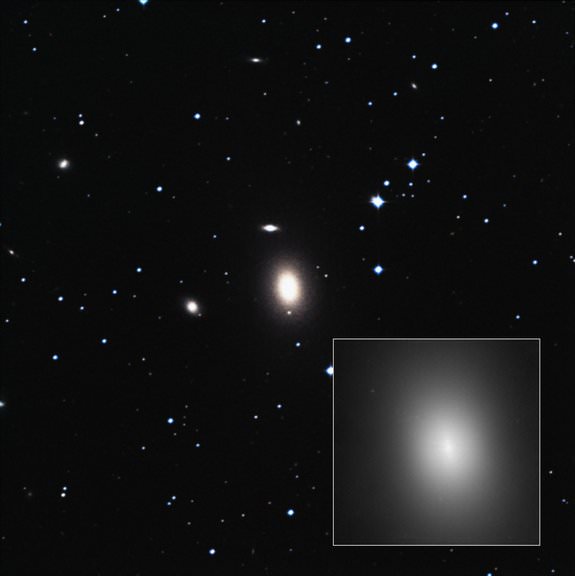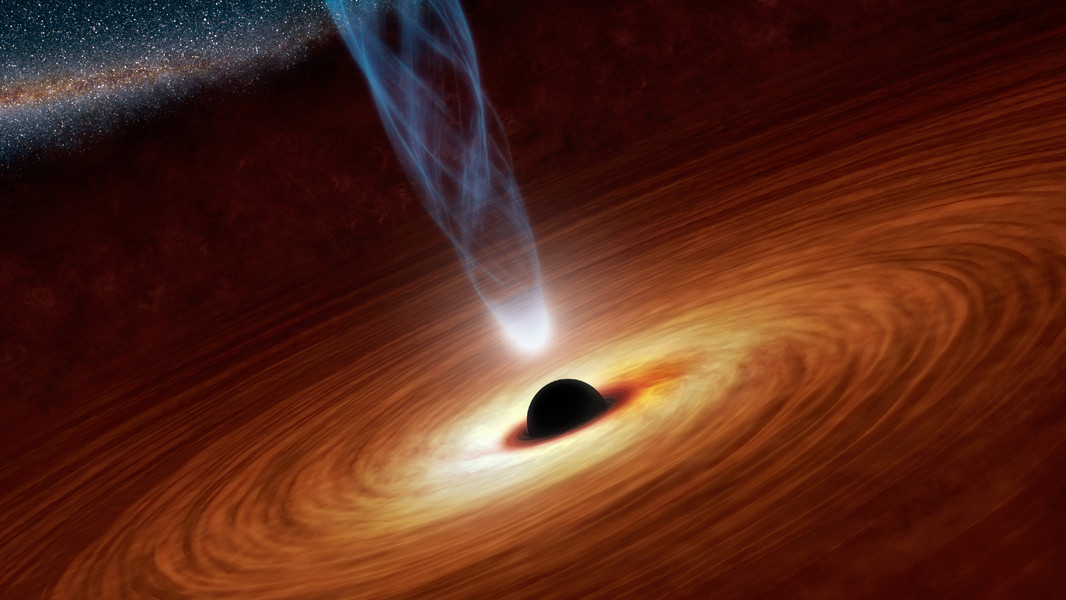Astronomers have found a massive black hole in a place they never expected to find one. The hole comes in at 17 billion solar masses, which makes it the second largest ever found. (The largest is 21 billion solar masses.) And though its enormous mass is noteworthy, its location is even more intriguing.
Supermassive black holes are typically found at the centers of huge galaxies. Most galaxies have them, including our own Milky Way galaxy, where a comparatively puny 4 million solar mass black hole is located. Not only that, these gargantuan holes tend to be located in galaxies that are part of a large cluster of galaxies. Being surrounded by all that mass is a prerequisite for the formation of supermassive black holes. The largest one known, at 21 billion solar masses, is located in a very dense region of space called the Coma Cluster, where over 1,000 galaxies have been identified.
The largest supermassive holes also tend to be surrounded by bright companions, who have also grown large from the plentiful mass in their surroundings. (Of course, its not the black holes that are bright, but the quasars that surround them.) The long and the short of it is that supermassive black holes are usually found in galaxy clusters, and usually have other supermassive companions in the same region of space. They’re not found in isolation.
But this newly found black hole is in a rather sparse region of space. It’s in NGC 1600, an elliptical galaxy in the constellation Eridanus, 200 million light years from Earth. NGC 1600 is not a particularly large galaxy, and though it has been considered part of a larger group of galaxies, all its companions are much dimmer in comparison. So NGC 1600 is a rather small, isolated galaxy, with only a few dim companions.

There’s another way that supermassive holes can form. Instead of growing large over time, by feeding on the mass of their home galaxies and galaxy clusters, they can form when two galaxies merge, and two smaller holes become one. But even this requires that they be in a region where galaxies are plentiful, allowing for more collisions and mergers.
It may be possible that NGC is the result of a merger of two galaxies, or that it is two black holes that are currently merging. Or it could be that NGC 1600’s region of space was once extremely rich in gas, in the early days of the Universe, and that’s what gave rise to this ‘out of place’ supermassive black hole.
There is much to be learned about the conditions that give rise to these behemoth black holes. The MASSIVE study will combine several telescopes to survey and catalogue the largest galaxies and black holes. This should tell astronomers a lot about their distribution, and about the circumstances that allow them to exist. We might find even larger ones.


Just a guess, but I believe there could be supermassive holes with absolutely no stars around them floating in the voids of the cosmic web. And I would speculate they got there by near misses with other supermassive holes in other galaxies.
Interesting idea, but testing it will be difficult because observing these solitary objects is hard. They’ll be dark and almost invisible.
One could attack the problem from two directions: first, look for more objects like this one, with comparatively few stars but still enough that you can spot them. Do their velocities often differ from the surrounding galaxies, in a way that suggests past close encounters? If so, that would suggest that there are similar black holes that might have lost all of their stars and not just most of them.
Second, run computer simulations of these hypothetical close encounters. Is it plausible that a black hole could shed all of its companion stars?
This entire posting is screwy. First the title implies an isolated SMBH, all by itself out in a void. Then we learn that it’s in a galaxie. What is so unusual about that except that this hole is a bit large for its parent?
The author describes SMBHs as usually being “surrounded by bright companions”. Bright stars? Bright galaxies? A quasar? Come ON! Last I knew a quasar was a very hungry and feeding black hole (and its immediate surroundings) all by itself in the center of a galaxy with no other companions of its ilk in sight – EVER!
And he says they usually have “other supermassive companions in the same region of space”. I thought that especially SUPER massive holes had only the stars of their galaxy in their “region of space” – or does this region include an entire group?. This is anything but clear.
Mr. Gough, it would be appreciated and very helpful if you were to define your scale or scales before writing of things being out of or displaced from their “normal” regions. – As in how far is NGC 1600 from any appreciable group of galaxies?